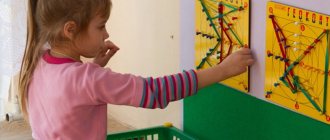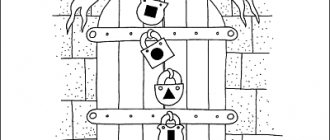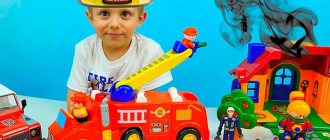Game 1. “Exchange”
In the store, children see you take money out of your wallet. Will they be able to raise the required amount themselves? The first game will teach your child to distinguish coins, change banknotes and collect the same amount in different ways.
How to play
You probably have a lot of loose change. Pour it onto the table and tell your child what types of coins there are. Let us look at them, compare size, weight, color, thickness.
Do the same with banknotes.
Explain that money is a constructor. We collect from them the amount that we give in the store for purchases. Show your child how it works: for example, collect 10 rubles from coins in several different ways (from coins of 1 ruble, 2 rubles, 5 rubles, etc. - the combinations can be different).
Now invite your child to “change” your money. Let him change you 10 rubles, 50 rubles, 100 rubles in coins.
Result
This game will teach your child to recognize and count money. Want to make the process more exciting? Invite your child to collect different combinations of the same amount of money at speed.
Financial literacy games for kids
Game 1 “Children are thinking”
Ask children questions. The game develops speech, thinking and horizons.
For example: How do you understand...
- What is money?
- What is money called in Russia?
- What is a bank?
- What is an ATM?
- Why do you need a plastic card?
- What kind of money is there?
- What would you do if you had a lot of money?
- What is income?
- What are expenses?
- Do you need to save money?
- What happens if you buy everything you want?
- What are necessary expenses? Find them on this list.
- Electricity and water for the home
- Magazine, cinema tickets
- Meat, fish, vegetables and fruits
- Cake, cookies, soda, candy
- Phone and internet bills
- Warm shoes and jacket for winter
- Attractions
- Bus pass
- Lottery ticket
- Books for school
Game 2 “Guessing riddles”
1. Small, round, jumps from pocket to pocket, leaps ahead of the whole world, is good for nothing, but needs everything. (Coin)
2. How they don’t take care, but get shaken. (Money)
3. There are 100 of us sisters in a ruble. We go through a lot of hands. They lose us and change us, and sometimes they scold us. One sister will disappear, and you'll see there's no ruble. (Kopeyka)
4. Name not just one, but three kopecks in the old days. (Altyn)
5. What they check without leaving the cash register. (Money)
6. He was born in America and set out to travel. Since then he has been walking around the world, Knowing his worth everywhere. They trade with him, manage him... What does everyone call him? (Dollar)
7. To consume food, to flaunt in fashionable dresses, to eat and drink deliciously, you need all this... (Buy)
8. We are born into the world in abundance for everyone. Some have a lot of us, while others don't. (Money)
9. We put them in our wallet and go to the store with them. Take at least something in return for them, except honor and love. (Money)
10. Each of them has dignity, And according to it they give honor to each - A pinch of one, a pound of the other. But, of course, I won’t compare them: Without the little one, there won’t be a big one. And you have had to meet someone like this. (Money)
11. People go to the market. Everything is cheaper there. (Goods)
12. The product must have...(
Price
)
13. They will be intact, like in a tank, Your savings will be in... (
Bank
)
14. Both the doctor and the acrobat are given for work... (Salary )
15. From what apparatus are our salaries issued?(
ATM
)
16. To store my income, For pocket money, I need Piggy, The one with the hole in the back. (TO
sawdust
)
Game 3 “Complete the phrase”
Complete the phrases:
- The coin is round, and the banknote….. (rectangular)
- The banknote is paper, and the coin is ....(iron, copper, metal)
- The coin rings, and the banknote…. (rustles, rustles)
- The coin is metal, but the banknote is... (paper)
Game 4 “Phraseological units”
- Spending money......spending a lot of money thoughtlessly
- Suitcase of money......have a lot of money
- Money doesn’t smell...... you can earn it with any work
- Money to money…… save up a small amount
- Money is like birds, it flies away and then it comes... today there is money, but tomorrow it is gone, it’s all spent
- Money doesn't bite......a lot of money
- Swimming in money......a lot of money
Game 5 "Shopping"
Clap your hands if money can buy this product. Stamp your foot if you can’t buy it.
House, candy, book, ice cream, happiness, mother, flowers, telephone, sun, milk, health, scooter, air, planet, laughter, dream, table, bicycle.
Game 6 “Solving financial problems”
You will find colorfully designed financial problems for the development of logic and mathematical abilities in this interesting book.
O. Naumova “Financial literacy for preschoolers”
A modern, useful guide for preschoolers and primary schoolchildren. The book is written in a fun, playful way and teaches kids practical life skills for handling money. All tasks in the book are related to money and its practical application in life.
The book promotes:
- development of mathematical abilities;
- development of logic;
- attention training;
- mental arithmetic training;
- development of problem solving skills;
- training fine motor skills of the hand, etc.
Result for the child:
- learn to count money;
- learn to solve your first economic problems;
- it will be better to navigate in real life when making various purchases;
- will not experience difficulties when meeting financial problems in a mathematics course;
- will train attention and logic.
The book will be of interest to children aged 5 years and older. The tasks in the manual can be used both individually and in group work.
I hope the article was useful to you. I also recommend that you read other useful articles in the PREPARATION FOR SCHOOL section.
Sincerely, Olga Naumova
Game 2. “Shop”
Now the child knows that any amount can be added up from different money. What to do with this money? That's right - go to the store and pay for your purchases.
Practice going to the store at home.
How to play
Just like in childhood, only instead of leaves, take real coins and small bills.
Place “goods” on the table: toys, food from the refrigerator. Attach a price tag to each product. Agree who will be the “seller” and who will be the “buyer.”
If the “buyer” is a child, then he will have to collect the required amount of bills and coins and give it to you in exchange for the goods. If the amount is more, let him wait for the change. Then switch roles. Now the task of the child “seller” is to check whether you gave him the money correctly. And if necessary, return the change.
Result
This game teaches the child the basic principle of commodity-money relations: in order to acquire something, you need to pay for it. The seller will receive this money and use it to develop his business - buy new products or improve those he is currently selling.
Financial vocabulary for kids
- A bank is a place where people can carry out various transactions with money.
- Deposit is money that was brought to the bank and given to be kept there.
- An ATM is a device that allows you to withdraw or deposit money onto a bank plastic card.
- Assets are anything that brings in money.
- Liabilities are what take money.
- Money is pieces of paper or coins that serve as a general exchange. For example, for money you can buy anything in a store, or go to the movies. Different countries have different money.
- Card - fully called a bank payment card. This is a piece of plastic that you can use to pay for purchases in stores, online, and many other places.
- A loan is money that a person, if he lacks for something, can ask to borrow from a bank. For example, if you want to buy a computer, but you don’t have enough money, the bank can lend you money. But then the bank will have to repay the debt and pay interest.
- A bill or banknote is what paper money is called. A bill or banknote is one piece of paper.
- Cash flow or profit is the difference between income and expenses over a period of time.
The following types of coins and banknotes are currently in use in Russia:
Game 3. “Quest in the supermarket”
Previous games taught the child to distinguish money by face value and pay for purchases. It's time to test your knowledge in practice.
How to play
Invite your child to go to the store. Explain that this time he will be in charge: he will need to make sure that you bought all the planned goods and whether there was enough money for them.
1. Together with your child, make a shopping list and prepare the amount you plan to spend in the store.
Advice: let the shopping list not be long (maximum three or four items), and the amount of money not very large, so that it is easier for the child to navigate it (two hundred to three hundred rubles).
2. Walk around the store with your child. His task is to collect all the goods from the list and meet the planned amount. Draw your child's attention to the fact that goods from the same category (for example, milk) may cost differently. The price depends on the name of the manufacturer and the volume of goods.
3. Towards the end of the shopping trip, invite your child to buy an expensive item not on the list - for example, a box of sweets. If the child agrees, ask: does he have enough money? Of course, there is not enough money for everything. Then offer him options: either you refuse to purchase goods from the list and buy a box of sweets, or you put off the sweets for later and go to the checkout only with those purchases that you planned in advance.
Let the child choose.
Result
At the end of this game he will learn several things at once:
Firstly, he learns that before going to the store he needs to make a shopping list. This makes it easier not to add too much to your basket and waste all your money.
Secondly, he learns that the same goods can cost differently. And the most expensive product is not necessarily the best.
Thirdly, he learns that all purchases are divided into desirable and necessary. A box of sweets is a desirable splurge. Sweets are delicious, but if you have milk and sunflower oil at home and don’t have much money with you, you can do without sweets. That is, in this case, a box of sweets is a desired purchase, and milk and sunflower oil are necessary.
The fourth lesson is waiting for him at the checkout. The child will have to pay for purchases and check the change that the cashier will give him. Invite your child to keep the change. He can spend it on a toy or something tasty, or he can put it in a piggy bank.
Hurray, the quest is completed. Repeat it periodically with your child - this way he will soon learn to be smart about spending.
Didactic games in economics for older preschoolers with goals
Card index of didactic games on the economic development of children of senior preschool age 5-7 years.
The material will be useful to preschool teachers of any type who implement gaming technology in their work.
Game “Train of Coins and Banknotes” Purpose: to teach how to build a sequence of increasing and decreasing the value of coins and banknotes. Material: A set of coins for each child for practical activities, a “train of coins and bills”, where children can arrange coins and bills in increasing and decreasing sequence; Progress of the game: - A “train of coins and bills” came to visit us. What kind of cargo do you think he is carrying? (coins) - Correct, but the coins on this train are located in a certain order. The first carriage carries a coin of the highest denomination. Look at your coins, which coin can travel in the first carriage? - Let's put a 5 ruble coin in the first carriage, what coin will go in the next carriage? Next, the children distribute the coins among the cars in descending order of denomination. - What coin is in the last carriage? This means that this coin is of the lowest denomination (1 kopeck). You can ask the children questions about this task: Which coin is in the carriage between 1 kopeck and 10 kopecks? - Guys, is it possible to distribute banknotes among the carriages in the same way (children distribute banknotes among the carriages). Game “If..., then...” Goal: introduce the following concepts into the active vocabulary: “grocery store”, “manufactured goods store”, learn to differentiate concepts, find similar and distinctive features; Clarify children's ideas about different types of stores. Progress of the game: - Guys, I will tell you a sentence, and you will have to continue this sentence, for example, “If you go to a grocery store, what can you buy there?” • If you go to a shoe store, what can you buy there? • If we go to a clothing store, what will we buy there? • If we go to a furniture store, what will we buy there? • If you go to a grocery store, what can you buy there? • If you go to a department store, what can you buy there? The game “What is sold where?” Goal: to learn how to distribute items for sale in different types of stores. Material: pictures depicting various types of goods. Progress of the game: - Look, guys, here we have a lot of goods that you can buy in the store. In which store can you buy these products? We look at pictures with children depicting goods (bread, loaf, sausage, skirt, shampoo, washing powder, toothpaste, jacket, and others). Together with the children, we determine which store sells the presented product. Game "Expensive - Cheap". Goal: to teach children to correlate the price and quality of a product. Material : morphological table with the names of different types of stores and products sold in them. Red signs indicate expensive goods, blue signs indicate cheap goods. Progress of the game: - Look, guys, we have various goods here. And I have such interesting signs - blue and red - the blue sign indicates a cheap product, and the red sign indicates an expensive product. What do you think is the most expensive and cheapest product? Lay out the signs. — Place red signs near expensive goods, and blue signs near cheap goods. Why did you decide so? Game “Shop” Purpose: to teach children to practically carry out the actions of purchasing goods, to say out loud the phrase “WORTH IT,” “I’M CRYING,” “CHANCE.” Material: small goods or illustrations of goods, price tags; money to buy goods for each child, product catalogs, price tags. Progress of the game: - Guys, let's play shop. - What do we need for this? — The right product, put price tags on the product, put it on the shelves. Together with the children, we determine the prices of goods, write price tags, and arrange goods on shelves.
We choose a seller or the teacher himself can play this role at the beginning of the game. We require the following sequence of questions and answers from children: - What, Masha, do you want to buy?
— I want to buy milk. It costs 12 rubles. I give you 15 rubles. - Here's 3 rubles in change. We interview several children. Then you can change the seller. Game "Auction" Purpose : to teach children to establish a connection between price, cash amount and change. Material : small goods or illustrations of goods, money. Progress of the game : All children are given money to purchase goods.
- Look, guys, I have a beautiful teddy bear in my hands.
Who wants to buy it? — The bear costs 5 rubles. - Who will buy Mishka? -There are many people who want to buy the Bear, then I add the price. The bear costs 6 rubles. Who has that amount of money? Next, we sell a few more toys to the children. You can use the word “Cost” (What is the cost of Mishka?) to introduce it into the child’s active vocabulary. Outdoor game “Find a Pair” Purpose : to teach children to establish the relationship between the dignity of money. Material : coins and bills of different denominations (one set of coins and bills for each child). Progress of the game: Children dance to the sound of music; when the music stops, children must find a pair according to the value of the coins. A pair consists of children, where one has a coin of a lower denomination, and the other has a coin of a higher denomination. Game "What does it do?" Goal : Clarify the names of such professions as doctor, teacher, driver, artist; strengthen children's ideas about professions. Progress of the game: - I will tell you the profession, and you will name what the person does. Cook - cooks porridge; Turner – makes parts; Doctor – treats people; A teacher teaches children; Driver – drives the car; Seller – sells products and goods; — What other professions do you know? What do people in these professions do? The game “Who works where?” Goal : learn to establish a connection between a person’s place of work and profession. Progress of the game: - Works in the police... - Works in a store... - Works in a bakery... - Works in a taxi... - Works in a fire department... - Works in a school... - Works in a hospital... You should draw the attention of children to what can be called not one profession, but several: Doctors, nurses, cleaners, cloakroom attendants, etc. work in the hospital. Game "Shop". Goal : - consolidate the concept of “store”, various types of stores; — introduce the rules of behavior in the store; — practically consolidate the rules of behavior in the store in a gaming situation; — cultivate a culture of behavior in public places; Material: Products for sale, price tags, display cases, supposed cash register, money for purchasing goods. Progress of the game: Together with the children, we decorate the store windows and paste the prices of the goods. Organize 3 children to work in the store itself. The first child is a cashier, sits at the register and punches out checks. Two children play the role of sellers: they offer children - buyers the goods presented in the store. It is important that children follow the rules of behavior in the store when purchasing goods. If the rules are not followed after the game, comment on the mistakes without getting personal, but identify typical mistakes. After some time, you can change the sellers so that they can demonstrate the rules of behavior in the store. Behavior rules. — When you come to the store, how should you behave? — What rules of conduct exist in public places? • You need to walk around the store floor quietly and calmly. You can talk in a low voice, consult with each other. Why? • In a store, you need to carefully examine the products on the shelves, choose the product you like, find out its price, check how much money you have in your wallet, and then make a purchase decision. Why? • If necessary, you need to seek advice and find out how to use the chosen item. Preference should be given to quality products. Why? • Do not forget when talking with the seller and cashier about words such as “thank you”, “please”, etc. • When talking with the seller, be patient, do not interrupt, listen to the end. • Having made a firm decision about what product you will buy and remembering its price, go to the cashier, pay for the purchase, and receive a receipt. • Go to the seller with the receipt and explain what toy you are buying. • Check again the quality of the purchased item: whether it has any breakages or whether its appearance is spoiled. Why? • Remember what words to thank the seller. Questions will help children discover the essence of some rules and understand their importance and necessity. The teacher explains some rules to the children himself, and some can be asked to explain to the children.
We recommend watching:
Economic education of preschool children Notes on economics in the senior group of a preschool educational institution Essay by a kindergarten teacher. Formation of financial literacy in preschool children Introductory course on teaching the basics of financial literacy to children of the middle group of preschool educational institutions
Similar articles:
About the profession of a banker for children
When should you start teaching children how to handle money?
“You can play financial games with children as early as 5 years old. Although, of course, all children are different. There are children who, from the age of 4, can read and count up to 20. And at the age of 4 they will ask you to give them money so they can buy something themselves. And children who have already learned to write make their own shopping list and purchase goods strictly according to the list (even some mothers are not allowed to “spend money”, but are helped to save money).
As the child grows, the games can become more complex. You can play as a financial advisor, trader, banker. Be sure to take your child to banks, an insurance company, a tax office, a pension fund, a brokerage company, a real estate company, and even to the stock exchange (you can also visit money museums, go to a numismatist, and an antique shop). At the age of 10–12 years, children have the greatest interest in money. At this time, it is especially good to play board games: “Cash Flow for Children”, “Cash Flow for Adults”, “Monopoly”, “Monopoly with Bank Cards”.
Board and printed game "Economic Journey"
Printed board game “Economic Journey” for preschool children from 5 years old
Game developer:
teacher 1st category
Mosolova Alena Dmitrievna
Explanatory note
The modern world is quite rich in all kinds of games, board games
– this is a separate whole huge world for children.
Tabletop content
games are very diverse.
This includes: inserts, puzzles, cubes, pyramids, mosaics, various lacing, construction sets
, lotto, dominoes.
Some types of lotto and paired pictures introduce children to individual objects (dishes, furniture, animals, birds, vegetables, fruits) and introduce them to their qualities and properties. Others clarify ideas about seasonal natural phenomena (seasons, various professions). A large selection of board and printed games on a wide variety of topics: classification, generalization, comparison, counting, composing problems, associations. A huge variety of games for the development of speech of preschoolers - accumulation of vocabulary, development of phonemic processes, lexico-grammatical representations, coherent speech of children, development of cognitive interests of children, teaching foreign languages, etc. Therefore, we can say that an infinite number of games have already been created for children board
games for their harmonious development.
What is the importance of tabletop
game for child development?
Play, first of all, is the main activity of preschool children. In the words of V. A. Sukhomlinsky: “Game is the spark that ignites the flame of inquisitiveness and curiosity of children.” Therefore, board games
Naturally, they develop the intellectual and positive abilities of children, the positive emotions of the child.
Children develop memory, attention, and imagination. In the process of playing
, children develop all aspects of the child’s personality: compliance, tolerance, cooperation, as well as concentration, perseverance, the ability to complete a task, discipline - these are the qualities that children need when studying at school.
In addition, play is very important for education
preschoolers have strong-willed character traits: the ability to set a goal, find means to achieve it, and overcome difficulties.
Board games at an older age develop habits of correct behavior and help children master the rules of the game
, do not break them, “take turns”, do not get angry at peers who make mistakes in the game.
The human brain is very interestingly designed in such a way that it does not forget anything and puts everything away in its so-called “briefcase”; all lost situations and qualities in children are reinforced, assimilated, appropriated by the child, and become habitual norms of behavior. That is why, as part of the implementation of the partial program “Economic education for preschoolers: developing the prerequisites for financial literacy” (5-7 years old), I developed a printed board game to reinforce the basics of financial literacy. Together with the children, we decided to create our own economic game, came up with the rules and goal of the game. As a result, we came up with a wonderful walking game “Economic Journey”
with economic rules.
Educational purpose
games - to help children aged five to seven years old enter into socio-economic life, to contribute to the formation of the foundations of financial literacy in children of this age.
Tasks:
to form in children the understanding that money cannot be taken just like that, it must be earned,
teach to understand and appreciate the surrounding objective world (the world of things as a result of people’s labor);
apply acquired skills and abilities in real life situations;
respect people who know how to work and earn money honestly;
promote the formation and development of children's imagination, communication abilities, and interaction skills.
Purpose of the game
– reach the finish line, in this game – to the bank and put all the accumulated coins into the bank.
Game progress: players, by throwing a dice, can ride a train, an airplane, have fun on attractions, eat pizza, ice cream or other sweets, and they can also fly on a parachute and even get to the pirates. For each item you will have to incur costs and pay coins, their number is indicated on the playing field (for example, -1). But during the game you can also earn coins (the number of coins is indicated on the playing field, for example, +3) by doing good deeds, which the participant in the game must come up with independently. The essence of the game is to go to the bank and put coins in storage. The students in my group found it very interesting and exciting to create a game on their own.
Audience of the game: children from 5 years old.
Subject: basics of economics and financial literacy.
Materials for creating a game: Whatman paper, sponges, gouache, brushes, ruler, paper for making cubes, colored paper for making coins.
The game "Economic Journey" is completely author's development.










